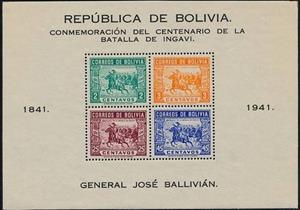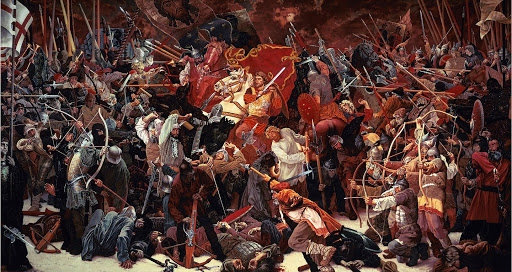Souvenir Sheet: Battle of Ingavi (Bolivia 1943)
Battle of Ingavi (Bolivia 1943)
01 January (Bolivia ) within release Battle of Ingavi goes into circulation Souvenir Sheet Battle of Ingavi face value 75 Bolivian centavo
| Souvenir Sheet Battle of Ingavi in catalogues | |
|---|---|
| Michel: | Mi:BO BL1C |
Souvenir Sheet is horizontal format.
Also in the issue Battle of Ingavi:
- Souvenir Sheet - Battle of Ingavi face value 75;
- Souvenir Sheet - Battle of Ingavi face value 12;
Souvenir Sheet Battle of Ingavi it reflects the thematic directions:
The horse (Equus ferus caballus) is one of two extant subspecies of Equus ferus. It is an odd-toed ungulate mammal belonging to the taxonomic family Equidae. The horse has evolved over the past 45 to 55 million years from a small multi-toed creature, Eohippus, into the large, single-toed animal of today. Humans began to domesticate horses around 4000 BC, and their domestication is believed to have been widespread by 3000 BC. Horses in the subspecies caballus are domesticated, although some domesticated populations live in the wild as feral horses. These feral populations are not true wild horses, as this term is used to describe horses that have never been domesticated, such as the endangered Przewalski's horse, a separate subspecies, and the only remaining true wild horse. There is an extensive, specialized vocabulary used to describe equine-related concepts, covering everything from anatomy to life stages, size, colors, markings, breeds, locomotion, and behavior.
A battle is an occurrence of combat in warfare between opposing military units of any number or size. A war usually consists of multiple battles. In general, a battle is a military engagement that is well defined in duration, area, and force commitment.
An army, ground force or land force is an armed force that fights primarily on land. In the broadest sense, it is the land-based military branch, service branch or armed service of a nation or country. It may also include aviation assets by possessing an army aviation component. Within a national military force, the word army may also mean a field army.



